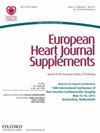Factor XI inhibition in patients with acute coronary syndrome
IF 1.7
4区 医学
Q3 CARDIAC & CARDIOVASCULAR SYSTEMS
引用次数: 0
Abstract
A hypercoagulable condition is typical of patients with acute coronary syndrome and is a determining factor in the genesis of recurrent ischaemic events. Modern pharmacological therapies consisting of antiplatelets and anticoagulants derive their rationale for use on the pathophysiological mechanisms most commonly associated with myocardial infarction (MI); they have contributed to reducing the ischaemic risk of these patients, but left ample room for improvement. In particular, trials that have studied the association of an anticoagulant with antiplatelet drugs have provided promising results in terms of efficacy, but highlighted a significant bleeding risk. Evidence derived from experimental animal and epidemiological studies has shown how factor XI (FXI) deficiency is associated with a reduction in thrombotic events but with modest bleeding. These data added to the role that FXI plays in the coagulation cascade constituted an incipit for the pharmacological attempt to decouple thrombosis from haemostasis by means of the inhibition of this factor. The theoretical assumption that FXI inhibitor drugs may be able to reduce the ischaemic risk without significantly increasing the haemorrhagic risk makes these compounds a potential therapeutic aid for patients in secondary prevention after acute MI. To date, on these patients, we only have data from a Phase 2 trial, PACIFIC-AMI (Study to Gather Information About the Proper Dosing and Safety of the Oral FXIa Inhibitor BAY 2 433 334 in Patients Following an Acute Heart Attack). In this study, the primary endpoint—represented by the Bleeding Academic Research Consortium (BARC) composite of Type 2, 3, or 5 bleeding—showed no significant differences between the various doses of asundexian tested (10, 20, and 50 mg quoque die), and between these and placebo (asundexian all doses vs. placebo: hazard ratio, 0.98; 90% confidence interval, 0.71–1.35). The data on efficacy, however, showed neutral results, but it should be noted that the study did not have the adequate statistical power to evaluate this outcome. Valuable information could, therefore, derive in the future from the ongoing Phase 3 trial with milvexian, LIBREXIA-ACS (A Study of Milvexian in Participants After a Recent Acute Coronary Syndrome) and from any future studies that could be started by testing different molecules.急性冠状动脉综合征患者体内的因子 XI 抑制剂
高凝状态是急性冠状动脉综合征患者的典型症状,也是导致反复缺血事件的决定性因素。由抗血小板和抗凝剂组成的现代药物疗法是根据心肌梗死(MI)最常见的病理生理机制而使用的;这些疗法有助于降低这些患者的缺血风险,但仍有很大的改进空间。特别是,研究抗凝剂与抗血小板药物联用的试验在疗效方面取得了可喜的成果,但也凸显了巨大的出血风险。来自动物实验和流行病学研究的证据表明,因子 XI(FXI)缺乏症与血栓事件的减少有关,但出血量不大。这些数据加上 FXI 在凝血级联中的作用,构成了通过抑制该因子使血栓形成与止血脱钩的药物尝试的诱因。理论上,FXI 抑制剂药物可以降低缺血风险,而不会显著增加出血风险,这使得这些化合物成为急性心肌梗死二级预防患者的潜在治疗辅助药物。迄今为止,我们只有一项 2 期试验 PACIFIC-AMI(收集急性心肌梗死后患者口服 FXIa 抑制剂 BAY 2 433 334 的正确剂量和安全性信息的研究)的数据。在这项研究中,以出血学术研究联合会(BARC)2、3或5型出血综合指标为代表的主要终点显示,所测试的各种剂量的asundexian(10、20和50毫克quoque die)之间以及这些剂量与安慰剂之间没有显著差异(所有剂量的asundexian与安慰剂相比:危险比为0.98;90%置信区间为0.71-1.35)。然而,有关疗效的数据显示结果是中性的,但应该指出的是,该研究没有足够的统计能力来评估这一结果。因此,目前正在进行的米维仙三期试验LIBREXIA-ACS(近期急性冠状动脉综合征后参与者的米维仙研究)以及未来可能通过测试不同分子而启动的任何研究都将为我们提供有价值的信息。
本文章由计算机程序翻译,如有差异,请以英文原文为准。
求助全文
约1分钟内获得全文
求助全文
来源期刊

European Heart Journal Supplements
医学-心血管系统
CiteScore
3.00
自引率
0.00%
发文量
575
审稿时长
12 months
期刊介绍:
The European Heart Journal Supplements (EHJs) is a long standing member of the ESC Journal Family that serves as a publication medium for supplemental issues of the flagship European Heart Journal. Traditionally EHJs published a broad range of articles from symposia to special issues on specific topics of interest.
The Editor-in-Chief, Professor Roberto Ferrari, together with his team of eminent Associate Editors: Professor Francisco Fernández-Avilés, Professors Jeroen Bax, Michael Böhm, Frank Ruschitzka, and Thomas Lüscher from the European Heart Journal, has implemented a change of focus for the journal. This entirely refreshed version of the European Heart Journal Supplements now bears the subtitle the Heart of the Matter to give recognition to the focus the journal now has.
The EHJs – the Heart of the Matter intends to offer a dedicated, scientific space for the ESC, Institutions, National and Affiliate Societies, Associations, Working Groups and Councils to disseminate their important successes globally.
 求助内容:
求助内容: 应助结果提醒方式:
应助结果提醒方式:


